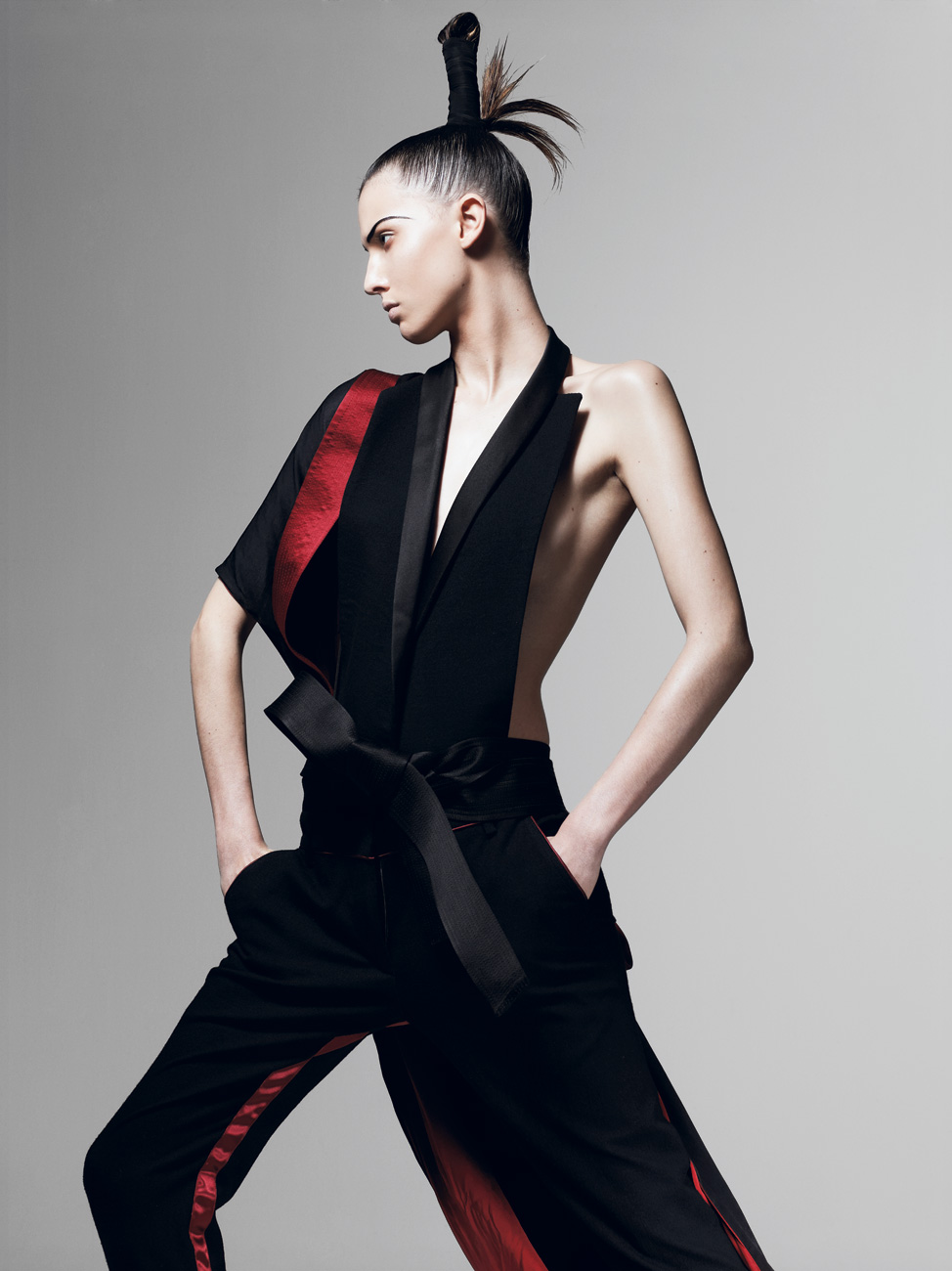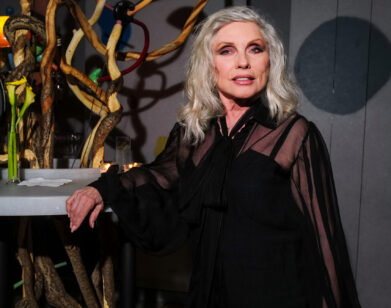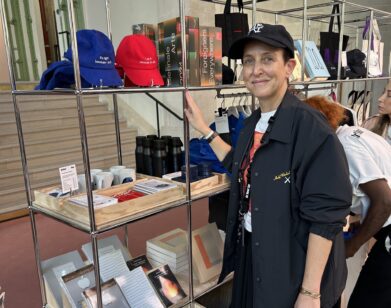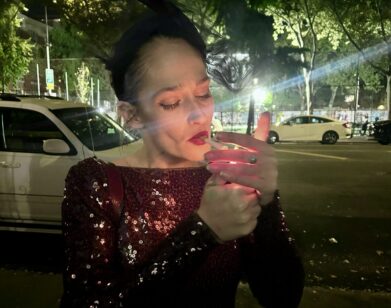Haider Ackermann

Haider Ackermann is having a moment. It’s a moment not unlike the ones that frequently occur during his runway shows, when a drape of fabric billows to reveal a flash of skin, or a leg moves to break a line, or a detail shifts to disrupt the meticulously arranged order of things: a moment where control has been ceded and things are in motion and what will happen will happen, and a kind of beauty emerges in watching it all unfold.
Since debuting his first collection in 2002, the Colombian-born Ackermann has boasted the proverbial small but devoted following of intellectuals, hipsters, and forward-thinking types—among them his interviewer here, the actress Tilda Swinton. But within the last couple of years, the larger fashion world has begun to catch on—and it has done so with a vengeance, as evidenced by the international critical response to his last few collections.
It hasn’t hurt, of course, that Ackermann, in his own vaguely professorial way, has a flair for the dramatic. At his pre-spring presentation at Pitti W last June, held in a palazzo in Florence, Italy, model Jamie Bochert opened the show by wandering off the runway and sitting down at a grand piano to perform a medley of songs that included “Knockin’ on Heaven’s Door.” Ackermann’s first men’s collection, unveiled that same night, was heralded as one of the most important debuts in menswear last year—then in December he announced that he would not produce another collection until he felt suitably compelled, setting the fashion blogosphere ablaze with incredulity.
It’s easy to see why so many people are suddenly becoming devout Ackermann-heads: The clothes are built for action. His elongated, sculptural silhouettes, often accented by arrays of loops, drapes, and folds in contrasting fabrics and colors, seem to come alive when worn and set in motion. His pieces incorporate elements of both high fashion and streetwear, ranging from long silk gowns and pleated maxiskirts to Perfecto-like jackets, and feature couture details rendered in materials like jersey and leather. They are impeccably tailored and fastidiously constructed but also romantic and sensual, and play with the notions of both fashion-as-armor and undressing-as-revelation. And they are undeniably sexy, but sexy in the sense that they keep you on your toes and seductively reel you in.
It’s impossible to say what role Ackermann’s upbringing has played in his work, but he has always had very specific ideas about fashion. His French-born father worked as a cartographer, causing his family to move frequently, so he spent his early years traveling around Europe and Africa, with stops in places like Algeria, Chad, and Ethiopia, before attending high school in the Netherlands. Upon graduation, Ackermann shuttled off to Belgium, where he studied fashion at the famed Royal Academy of Fine Arts in Antwerp, an avant-gardist hub that counts Ann Demeulemeester and Dries Van Noten among its alumni. But as Swinton notes in her conversation with Ackermann, there are certain tropes that have always floated in and around his collections—many of them having to do with the notion of travel and the anxieties and freedoms that come with the experience of moving between different cultures and being a stranger in a strange land. She caught up with Ackermann in Antwerp.
TILDA SWINTON: Tell me what this moment is like for you.
HAIDER ACKERMANN: You know what? I feel like I’m going through such a delicious phase of my life at the moment. It’s nice to feel desired—and I do feel desired work-wise but also privately. You know, we all want to be desired. So it feels very good.
SWINTON: I just feel this sense of satisfaction that what seemed so clear and inevitable to everyone around you for so long—that people would one day be open to your work—is finally taking place. You must feel very vindicated that there’s such a Haider-shaped space that you’re filling now for people beyond the few of us who’ve been invited into your world before.
ACKERMANN: You know, I really like to take the time to build things slowly and surely—to get more grounded. But it never felt for certain, like, “One day people will listen to me!” It was more like, “Perhaps I’ve got something to say.” So it feels fantastic. It’s good to take the time to think, to find, to search.
SWINTON: Let’s talk about time. You and I have discussed the idea of ultimate luxury before, and we have agreed that, for us, the ultimate luxury is time.
ACKERMANN: Yes. Because, especially, like now . . . Well, in terms of my work, the last collection was about the luxury of time and its relationship to the luxury of love and the luxury of living. It was also about my past, in a way—more elegant and more sophisticated. But to achieve those things, you need to have time. And when I say that, I’m not referring to things like the fabric or the sewing or the construction alone. It’s not about all of that. It’s more about a certain attitude that you take into your life—one where you take time to be loved, for instance. That’s why, perhaps, my most recent collection was less tormented. You know, today, everybody is always rushing. Designers have to make collections one after the other. Actresses have to make movies one after the other. They have to do all that in order to still be there—to still be out there. So to step away and be absent and to lose yourself completely and to really come back and find yourself again—that’s something quite rare.
SWINTON: Have you ever read a great essay by Robert Louis Stevenson called “An Apology for Idlers”?
ACKERMANN: No, tell me about it.
SWINTON: I’m going to send it to you. It’s a great piece of writing that advocates being idle. I don’t know exactly when I first discovered it. I mean, I’ve always been super-lazy myself—albeit in the kind of proper, dedicated way. But I remember when I first found this piece of writing, I felt that I was in good company—that Robert Louis Stevenson was advocating this sense of living according to one’s own internal rhythm and what I think corporate business might refer to as “wasting time.”
Photo: Haider Ackermann in New York, November 2010. All clothing and accessories: Ackermann’s own.
ACKERMANN: [laughs] Absolutely. That is why everything is so sped up. For instance, now, with our mobile devices, we send messages by SMS. We make every sentence very short. Whereas, in the past, you would take the time to write a love letter and you would think about what you wanted to say and compose it in a certain way. Now, everything is so short. It has to be, because it is rushed, and therefore, in a way, it loses a little bit of its importance. But I think it is very important to take the time to say what you want to say.
SWINTON: You mentioned the idea of a love letter—talk to me about the importance of gesture. It occurred to me recently how much of modern design is geared to the still frame, to the idea of a kind of outline or silhouette that is fixed in space and time. And it always feels to me like your work has been created with a certain gesture in mind. It needs movement in order to really sing. That’s something that I’ve always responded to—that your work is not made to live in a still image in a magazine. Your clothes are actually an experience—a sensual experience. When wearing your clothes, one can very much feel the outline of one’s own frame. It doesn’t feel like you’re hidden within the cage of something else.
ACKERMANN: Well, it’s the gesture and the attiude of the person that makes them seductive. The clothes are on second-term. The first element is just the attitude of the person, which makes everything so much more alive. You know, when you’re walking down the middle of this very, very narrow street, and a woman passes by you like a ghost? It’s like you just see those white veils, but then suddenly you will hear all the sounds—the fabric brushing, the clink of the jewelry—and it’s just so mysterious. I think that’s what attracted me when I was so young—that idea of these women who were passing by all the time. You didn’t know what would happen. Like, sometimes you would see some detail or discover a flash of skin of the knees. It’s quite beautiful and very, very sensual at the same time. So I really wanted, with this collection, for the woman I had in my mind to finally come out of the shadows. I love a woman with a kind of mystery you cannot really reach. I want her to exist on her own, coming out of her shell, to stand there and say, “Listen, this is what I am now.” I thought that was kind of seductive. It also has to do with me personally, because, as you know, fashion is a catalyst of my life, and with the collections, I’m very self-exposed, and at this moment, I’m feeling quite good, so I, too, just felt like coming out of the shadows.
SWINTON: It’s very interesting watching the way that you play with the whole idea of withdrawal and exposure. It feels like, from collection to collection, there is a sort of constant play with the paradox of revealing the body and hiding the body.
ACKERMANN: But it’s also about the contradiction. You know, you want to protect yourself. In my work, there is a lot of protection. Like, the past winter was a period of my life where I was really vulnerable, so after that, you just want to protect yourself. People will say of my work sometimes that my woman looks like a warrior. Well, I had a feeling that she just wants to protect herself, which is a totally different approach. I actually think she feels very fragile.
SWINTON: But I would add to that idea of protection by saying that she wants to incubate herself—to build up her own immune system so that she can go out into the world. It is a protected feeling, but it’s not defensive, necessarily. It’s a feeling of building up strength from within. It’s like you’re very consistently seducing . . .
ACKERMANN: [laughs] I think it’s always this duality, anyway, between protection and sensuality. The nakedness, the beauty of the skin . . . You know, I always try to have necks free because it’s the most sensual part of a woman.
SWINTON: So I know that you traveled a lot when you were younger. Tell me what places you’re dreaming about going these days.
ACKERMANN: [laughs] Far away ones to escape it all.
SWINTON: Where, particularly? In which direction?
ACKERMANN: I don’t know. I would like to go somewhere like Mongolia, or somewhere where I could just be surrounded by nature. I might even do Scotland.
SWINTON: Why don’t you come to Scotland, for goodness sake?
ACKERMANN: I know. I would love to lose myself in nature. I mean, to really find yourself with just a couple of friends is more than enough.
SWINTON: Well, I have the peculiar experience, very often, of people in cities asking me why on Earth I would live so far away from it all in the north of Scotland. But for us, it’s not away from anything. For us, it’s the center of the universe.
ACKERMANN: I’m sure it’s also important for you to get back and just escape everything and everyone in order to refill your batteries and to . . . Now, isn’t it?
SWINTON: But I think it’s possible to do both. It’s very important to acknowledge that, yes, there’s a part of one that wants to be in the heart of the wilderness. But it’s very important to engage with the world, as well. But I suppose, to be practical about what’s happened recently in your life, you have traveled a lot lately, to America specifically, and in a way that you maybe haven’t before. What has that been like?
ACKERMANN: Well, the sun was shining, obviously, and this person who is important to me was there with me, which made my journey absolutely excellent. You know, you have your meetings, you have your interviews, you have your shoots, and suddenly downstairs at the bar this person is waiting for you. You know how it is with your dude—it makes everything so much more beautiful. It’s nice to live through a good moment and be able to share it with someone else. Otherwise, what sense would it have? Selfishly, it doesn’t give you that much.
Photo: All Clothing: Haider Ackermann Spring/Summer ’11 collection. Cosmetics: Nars, including Sheer Glow Foundation. Hair: Anthony Turner using Tigi/Art Partner. Makeup: Diane Kendal/Art + Commerce. Model: Ruby Aldrige/Next. Casting: Michelle Lee/Kcd, Inc. Stylist Assistant: Elin Svahn. Special Thanks: Splashlight Studios.
TO STEP AWAY AND BE ABSENT AND TO LOSE YOURSELF COMPLETELY AND TO REALLY COME BACK AND FIND YOURSELF AGAIN—THAT’S SOMETHING QUITE RARE.Haider Ackermann
SWINTON: But it’s interesting, that feeling of foreignness that we as Europeans have in America. I remember the first time I went to America. I felt extremely alien, but I was also so bowled over by the openness and the warmth.
ACKERMANN: Because when you go to America as a European, you feel like a stranger, but at the same time you just feel like a beautiful stranger. We in Europe have a kind of path that we’re on. We have a long history, which is different depending on where we’re from, and which weighs heavily on our shoulders. But for us Europeans, America feels more dust-free, in a way. There is an openness.
SWINTON: I think it’s very true that as a European in Europe one feels the haunting of all the centuries of cultural ghosts that are there, and one has to find a way of placing oneself within the greater course. I don’t know if this is true, but it’s possible that, not being American, we don’t pick up on all the airwaves that Americans are geared to pick up on. We’re kind of like broken radios, where we turn the dial and nothing works. You know, when you had your show in Florence last year and you made your carnet de voyage, you asked me to contribute, so I wrote a piece about ghosts and time and this feeling in art that one is constantly downloading past spirits. But I find that that all gets disconnected when we Europeans go to the States. It frees us up to play in a way that we can’t necessarily play in Europe.
ACKERMANN: This is absolutely true. Have you been to Florence?
SWINTON: I have. Believe it or not, I was in an opera there directed by Derek Jarman in, I think, 1988. It was absolutely insane. But I wasn’t able to be there for your show. I’ve pored over the images of it, though. How was it making a debut in an extraordinary palace like the Palazzo Corsini?
ACKERMANN: When you’re traveling, you get inspired by the moment, and I was thinking at some point about who the man might be who is behind the Ackermann woman that I’ve tried to really find. I was searching for the man behind her, which is what I dealt with in the men’s collection. And being surrounded by all this beauty and all this history inspired me to create something that reflected or conjured that. It would suit you, actually.
SWINTON: Me? I’m wearing your menswear. I am the man behind the Haider Ackermann woman. [both laugh] But just thinking about being around this architecture and atmosphere that holds such history and so many ghosts . . . That is the luxury of aristocracy, I suppose—that feeling of being temporary and connected to some kind of longstanding theme, but not having to carry the whole brunt of it.
ACKERMANN: I was also imagining that this man would leave that all behind at some point, because sometimes when you come from a family or a lineage with such a weight from the past, you will be compelled to disappear. You will travel. You will seek to escape. You will try to lose yourself somewhere. And then you return to all you have. That, too, is a kind of beautiful idea to me.
SWINTON: The exiled prince who leaves his kingdom far behind.
ACKERMANN: Exactly. I think that’s a luxury—to have a nomadic life and to be a kind of bohemian. You feel totally free and you can adapt yourself very easily. But at the same time you can totally lose balance, because you don’t know where you belong anymore.
SWINTON: When you were a child, did you have a sense of where home was?
ACKERMANN: No. I still don’t. Now I’m French, and suddenly living in Paris for the last four years, but I have a feeling that I’ll only have a home when I put a flag in my house with the person I’m going to be with. That’s going to be my home. So I only see home in that sense. It’s where love is going to lead me. It can be anywhere, basically, as long as you are with the person you want to be with, so you can build something together.
SWINTON: That is, I think, a great privilege. Maybe your parents taught you that, because your home was with them. They taught you that home is not necessarily about a country or bricks and mortar, but actually spiritual business, and about either one other person or a group or a feeling of a kind of communion.
ACKERMANN: Exactly. But I would like to put my flag down somewhere. I’m going that direction. There is something very unstabilizing about not knowing where you’re coming from or where you’re going. There’s something very romantic about it, because you have this search for the unknown. But at the same time, sometimes I’m like, “God, if I were to die tomorrow, where would I like to be buried?” I wouldn’t know. That’s kind of a heavy thought, but it’s a fact. You don’t know anymore where you belong.
SWINTON: But you know how it is when you read a really crackling biography and you read one chapter and it’s, “They’re all settled in Sussex with four children and six dogs. . . .” And you turn the page and the title of the next chapter is, “The Colombia Years,” and they’re all drug-running in Colombia and the children have all gone to boarding school. And then you go to the next chapter and it says, “The Hollywood Years.” [Ackermann laughs] It feels to me that this is what happens in life; that home is a state of mind, a matter of choice, a movable feast. But, I think, in a way, being free of geography is a privilege, because it reveals to you very clearly that everything is in your own hands. You can be anywhere, go anywhere, and make of your days what you want.
ACKERMANN: Which is a luxury, again. These collections are, for me, in many ways, like writing a book. You just make one chapter after the other and hope the reader is going to be excited and want to read the next chapter. It’s just a continuation. I built up continuity on the same things.
SWINTON: I think that your work lends the opportunity for whoever wears your clothes to be the author of how they’re appearing and how they are feeling. You’re not ramming a text on them.
ACKERMANN: Well, I would hate the idea to dictate. Clothes should never be decoration. But what you said is the biggest compliment—that you just feel like yourself in my clothes. As a designer, you can try to reach that, because when someone feels at peace with the clothes, they feel more seductive, more desirable, more sensual, more everything.
Tilda Swinton’s most recent role was in I Am Love, which she co-produced. She will next be seen in We Need to Talk About Kevin.
Haider Ackermann

PHOTO BY STEPHANE FEUGERE
Choosing kimono dress as the core influence of a collection is risky business: Japan has been endlessly, colonially reinvented via Western eyes, from Paul Poiret to John Galliano. So how does one avoid Orientalist kitsch? Haider Ackermann, the Colombian-born, Antwerp-trained designer has picked this as his challenge for Spring 2011. His latest collection artfully deconstructs crossover jackets and large belts, and plays with silks—and for the first time, introduces bold colors into his somber palette. We met Haider after the show and talked of clichés, the Ackermann woman growing into maturity, and his vision of Antwerp.
ALICE PFEIFFER: When you pick a theme like Japan for a collection, how do you avoid clichés?
HAIDER ACKERMANN: I don’t know if you can ever avoid clichés; I just think that every designer brings his own translation to the reference, that’s all.
PHOTO BY BRUNO ALBIZATTI
PFEIFFER: What is the evolution with this collection, what’s new?
ACKERMANN: The use of colors is the newest element I suppose. I basically wanted my woman to come out of the shadow, and force herself into colors. I wanted her to find a way of expressing herself via these bold shades.
PFEIFFER: How would you describe “your woman?”
ACKERMANN: I think my woman is someone who speaks very little, who is very absent. But I thought it was time she found her own way of communicating, through colors.
PFEIFFER: How does that translate onto your use of materials?
ACKERMANN: For this collection, I did what I always do, which is mixing silk and leather. This gives a very sensual, as well as sexual result. I like this contrast of softness and stiffness all in one.
PFEIFFER: Where do you see the influence of Antwerp in your designs?
ACKERMANN: You know, I don’t believe in all this. There is no Antwerp, no Paris, no New York. We all travel enormously; we no longer belong to only one place. You are inevitably absorbed by every city you are in, by all the information around you. You just can’t sum it up to Antwerp.






